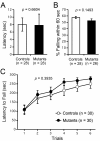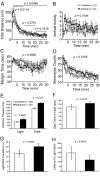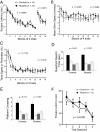M4 muscarinic receptor knockout mice display abnormal social behavior and decreased prepulse inhibition
- PMID: 22463818
- PMCID: PMC3361477
- DOI: 10.1186/1756-6606-5-10
M4 muscarinic receptor knockout mice display abnormal social behavior and decreased prepulse inhibition
Abstract
Background: In the central nervous system (CNS), the muscarinic system plays key roles in learning and memory, as well as in the regulation of many sensory, motor, and autonomic processes, and is thought to be involved in the pathophysiology of several major diseases of the CNS, such as Alzheimer's disease, depression, and schizophrenia. Previous studies reveal that M4 muscarinic receptor knockout (M4R KO) mice displayed an increase in basal locomotor activity, an increase in sensitivity to the prepulse inhibition (PPI)-disrupting effect of psychotomimetics, and normal basal PPI. However, other behaviorally significant roles of M4R remain unclear.
Results: In this study, to further investigate precise functional roles of M4R in the CNS, M4R KO mice were subjected to a battery of behavioral tests. M4R KO mice showed no significant impairments in nociception, neuromuscular strength, or motor coordination/learning. In open field, light/dark transition, and social interaction tests, consistent with previous studies, M4R KO mice displayed enhanced locomotor activity compared to their wild-type littermates. In the open field test, M4R KO mice exhibited novelty-induced locomotor hyperactivity. In the social interaction test, contacts between pairs of M4R KO mice lasted shorter than those of wild-type mice. In the sensorimotor gating test, M4R KO mice showed a decrease in PPI, whereas in the startle response test, in contrast to a previous study, M4R KO mice demonstrated normal startle response. M4R KO mice also displayed normal performance in the Morris water maze test.
Conclusions: These findings indicate that M4R is involved in regulation of locomotor activity, social behavior, and sensorimotor gating in mice. Together with decreased PPI, abnormal social behavior, which was newly identified in the present study, may represent a behavioral abnormality related to psychiatric disorders including schizophrenia.
Figures





Similar articles
-
Sleep, activity, temperature and arousal responses of mice deficient for muscarinic receptor M2 or M4.Life Sci. 2010 Jan 30;86(5-6):158-69. doi: 10.1016/j.lfs.2009.11.019. Epub 2009 Dec 1. Life Sci. 2010. PMID: 19958780
-
Hyperactivity and intact hippocampus-dependent learning in mice lacking the M1 muscarinic acetylcholine receptor.J Neurosci. 2001 Jul 15;21(14):5239-50. doi: 10.1523/JNEUROSCI.21-14-05239.2001. J Neurosci. 2001. PMID: 11438599 Free PMC article.
-
Decreased nesting behavior, selective increases in locomotor activity in a novel environment, and paradoxically increased open arm exploration in Neurogranin knockout mice.Neuropsychopharmacol Rep. 2021 Mar;41(1):111-116. doi: 10.1002/npr2.12150. Epub 2020 Dec 3. Neuropsychopharmacol Rep. 2021. PMID: 33270377 Free PMC article.
-
[Vasopressin receptor knockout mice as an animal model of psychiatric disorders].Nihon Shinkei Seishin Yakurigaku Zasshi. 2006 Apr;26(2):101-5. Nihon Shinkei Seishin Yakurigaku Zasshi. 2006. PMID: 16722468 Review. Japanese.
-
Using an animal model of deficient sensorimotor gating to study the pathophysiology and new treatments of schizophrenia.Schizophr Bull. 1998;24(2):285-301. doi: 10.1093/oxfordjournals.schbul.a033326. Schizophr Bull. 1998. PMID: 9613626 Review.
Cited by
-
The Pharmacology of Visual Hallucinations in Synucleinopathies.Front Pharmacol. 2019 Dec 9;10:1379. doi: 10.3389/fphar.2019.01379. eCollection 2019. Front Pharmacol. 2019. PMID: 31920635 Free PMC article. Review.
-
Neuromodulatory signaling in hippocampus-dependent memory retrieval.Hippocampus. 2015 Apr;25(4):415-31. doi: 10.1002/hipo.22394. Hippocampus. 2015. PMID: 25475876 Free PMC article. Review.
-
Positive allosteric modulation of M1 and M4 muscarinic receptors as potential therapeutic treatments for schizophrenia.Neuropharmacology. 2018 Jul 1;136(Pt C):438-448. doi: 10.1016/j.neuropharm.2017.09.012. Epub 2017 Sep 9. Neuropharmacology. 2018. PMID: 28893562 Free PMC article. Review.
-
Drug Design Targeting the Muscarinic Receptors and the Implications in Central Nervous System Disorders.Biomedicines. 2022 Feb 7;10(2):398. doi: 10.3390/biomedicines10020398. Biomedicines. 2022. PMID: 35203607 Free PMC article. Review.
-
Selective activation of M4 muscarinic acetylcholine receptors reverses MK-801-induced behavioral impairments and enhances associative learning in rodents.ACS Chem Neurosci. 2014 Oct 15;5(10):920-42. doi: 10.1021/cn500128b. Epub 2014 Aug 19. ACS Chem Neurosci. 2014. PMID: 25137629 Free PMC article.
References
-
- Levine RR, Birdsall NJM, editor. Life Sci. Vol. 60. 1997. Proceedings of the Seventh International Symposium of Subtypes of Muscarinic Receptors; pp. 963–1211. - DOI
-
- Levine RR, Birdsall NJM, editor. Life Sci. Vol. 64. 1999. Proceedings of the Eighth International Symposium on Subtypes of Muscarinic Receptors; pp. 355–593. - DOI
-
- Levine RR, Birdsall NJM, editor. Life Sci. Vol. 68. 2001. Proceedings of the Ninth International Symposium on Subtypes of Muscarinic Receptors; pp. 2449–2642. - DOI
Publication types
MeSH terms
Substances
LinkOut - more resources
Full Text Sources
Other Literature Sources
Molecular Biology Databases
Research Materials

